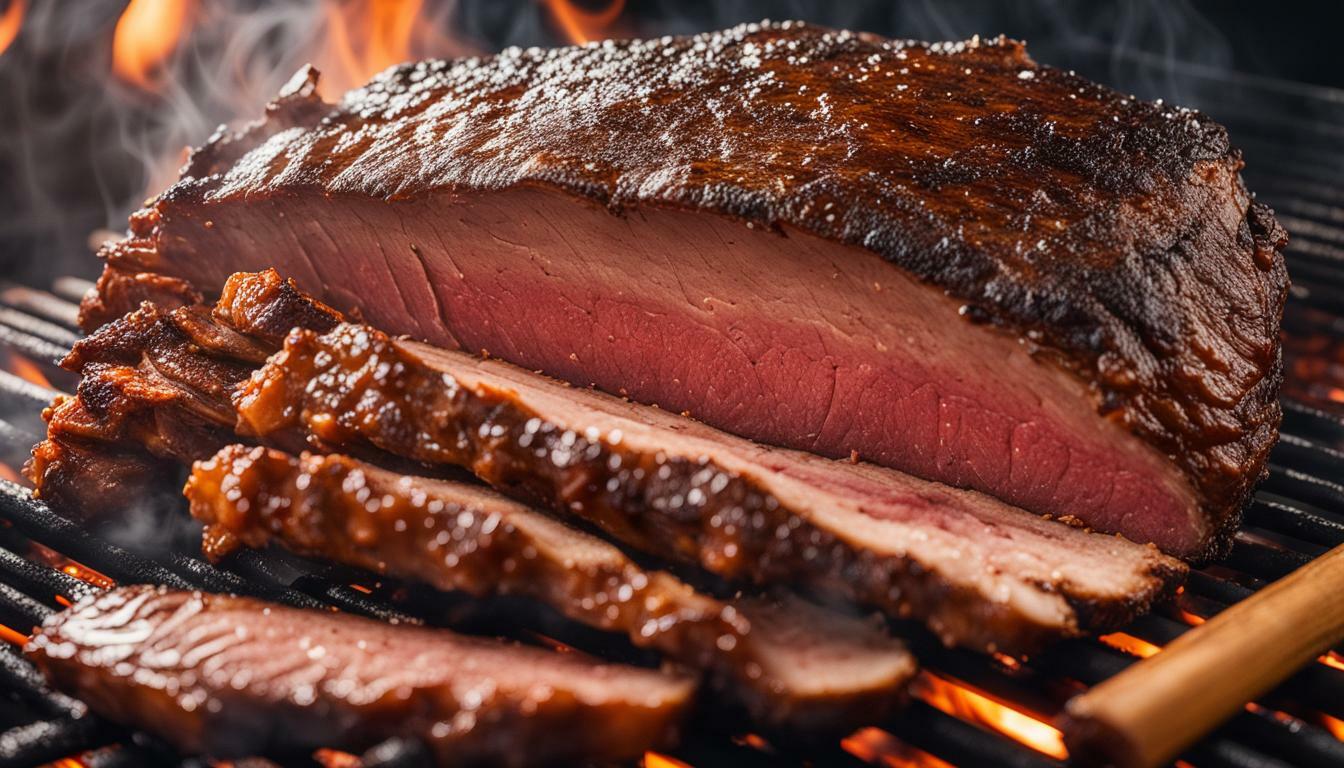
Cooking brisket to perfection requires more than selecting the right seasoning or smoking wood. One of the most critical factors is the temperature at which the meat is cooked. Achieving the optimal temperature for the point and flat cuts is key to tender and juicy barbecue that will have your guests coming back for seconds.
In this section, we’ll explore the differences between the point and flat cuts of brisket and the ideal temperatures to cook each one. Let’s get started!
Contents
- 1 Point vs Flat: Key Differences
- 2 Cooking Temperatures for Brisket
- 3 Tips for Achieving Brisket Doneness
- 4 Brisket Cooking Techniques
- 5 Resting and Slicing Brisket
- 6 Conclusion
- 7 FAQ
- 7.1 Q: What is the optimal temperature for cooking brisket?
- 7.2 Q: What are the key differences between the point and flat cuts of brisket?
- 7.3 Q: What is the recommended internal temperature for brisket?
- 7.4 Q: What are some tips for achieving the perfect doneness for brisket?
- 7.5 Q: What are some different brisket cooking techniques?
- 7.6 Q: How long should brisket rest before slicing?
Key Takeaways
- The point cut of brisket is typically more tender and contains more marbling while the flat cut is leaner and easier to slice.
- Low and slow cooking is key to achieving the desired tenderness for both cuts of brisket.
- Achieving the perfect doneness for brisket requires more than hitting a specific temperature; the texture must also be considered.
- Experimenting with different cooking techniques will help you find your preferred style.
- Resting and slicing brisket correctly is crucial to a more flavorful and moist final product.
Point vs Flat: Key Differences
Before discussing the optimal cooking temperatures for brisket, it’s important to understand the differences between the point and flat cuts.
The point cut, also known as the deckle or fatty end, contains more marbling and is typically more tender than the flat cut. This makes it ideal for slow smoking, which allows the fat to render and flavor the meat. The flat cut, on the other hand, is leaner and easier to slice, making it a popular choice for sandwiches and other dishes where thin, uniform slices are important.
These differences in fat content and texture can also influence the cooking temperature and techniques used for each cut. It’s essential to consider these variations when preparing your brisket to ensure optimal results.
Cooking Temperatures for Brisket
When it comes to smoking brisket, maintaining a consistent temperature is key to ensuring tenderness. Generally, a temperature of around 225°F (107°C) is recommended for both the point and flat cuts. However, some pitmasters prefer to cook at slightly higher or lower temperatures depending on their preferences.
For the best internal temperature for brisket, a general guideline is to aim for around 195°F (90°C). This temperature ensures that the tough connective tissue in the meat has broken down, resulting in tender, juicy meat. However, it’s important to note that the true test of doneness is the texture, not just hitting a specific temperature.
| Brisket Cut | Smoking Temperature | Internal Temperature for Doneness |
|---|---|---|
| Point | 225°F (107°C) | 195°F (90°C) |
| Flat | 225°F (107°C) | 195°F (90°C) |
It’s important to remember that the cooking time will vary depending on the size and thickness of the brisket. A larger cut of meat will require a longer cooking time to reach the desired internal temperature.
Experimenting with different smoking temperatures and internal temperatures can help you find the perfect combination for your preferences. Keep in mind that the goal is to achieve a tender and flavorful brisket, so don’t be afraid to adjust the cooking time and temperature as needed.
Tips for Achieving Brisket Doneness
Achieving the perfect doneness for brisket requires more than just hitting a specific temperature. While an internal temperature of around 195°F (90°C) is often aimed for, there are other factors to consider.
The thickness of the meat and the amount of fat can affect the final result, as can personal preference. The true test of doneness is the texture, and a properly cooked brisket will be tender and easily pull apart with a gentle tug.
Here are some tips to help you achieve the perfect brisket doneness:
- Use a meat thermometer to monitor the internal temperature, but rely on texture to determine when it’s ready.
- Don’t rush the cooking process – low and slow is key for tender brisket.
- Let the brisket rest for at least 30 minutes to an hour before slicing to allow the juices to redistribute throughout the meat.
- When slicing, cut against the grain to ensure tender slices.
With these tips in mind, you’ll be well on your way to mastering the art of brisket.
Brisket Cooking Techniques
When it comes to cooking brisket, there are many techniques to choose from. The key is finding the one that works best for you and results in the most delicious, tender brisket.
One popular technique is the Texas crutch method, which involves wrapping the brisket in foil or butcher paper when it reaches a specific temperature. This technique can speed up the cooking process and help retain moisture, resulting in a tender brisket.
Another approach is the low and slow method without wrapping, which allows for a longer cooking time to develop a robust bark. This technique can result in a flavorful, smoky crust that many brisket enthusiasts prefer.
No matter which technique you choose, it’s essential to monitor the brisket’s temperature throughout the cooking process. Aiming for a temperature of around 225°F (107°C) is a good starting point.
Remember, the key to achieving the perfect brisket is not just hitting a specific temperature but paying attention to the texture. Experimenting with different techniques and monitoring the temperature will help you find your preferred cooking style.
Resting and Slicing Brisket
Once the brisket reaches its optimal internal temperature, it’s tempting to dive right in and start slicing. However, it’s important to allow the meat to rest for at least 30 minutes to an hour before slicing. This gives the juices time to redistribute throughout the meat, resulting in a more flavorful and moist final product.
While resting the brisket, keep it covered with foil or butcher paper to help retain the heat. This also prevents the surface from drying out, which can affect the texture and taste of the meat.
When it comes to slicing brisket, it’s essential to cut against the grain. This means slicing perpendicular to the natural muscle fibers running through the meat. This results in tender slices that are easy to chew and enjoy.
Pay attention to the meat’s natural fibers, which will indicate the direction of the grain. Slicing against the grain requires a bit of extra effort, but it’s well worth it for the final result.
These simple tips for resting and slicing brisket will help you achieve the perfect texture and flavor for your barbecue. Remember to let the meat rest after cooking, and take your time when slicing for tender, delicious brisket.
Conclusion
In conclusion, the perfect brisket requires more than just a specific temperature. Understanding the differences between the point and flat cuts, as well as experimenting with different cooking techniques, can help you achieve the perfect texture and flavor. Remember to cook low and slow, and aim for an internal temperature of around 195°F (90°C) for tender meat. Don’t forget to let the brisket rest before slicing and cutting against the grain for the best results. With these tips and tricks, you’ll be able to master the art of brisket cooking and impress your guests with mouth-watering barbecue.
FAQ
Q: What is the optimal temperature for cooking brisket?
A: The optimal temperature for cooking brisket is around 225°F (107°C) for low and slow cooking. However, different pitmasters may have their variations.
Q: What are the key differences between the point and flat cuts of brisket?
A: The point cut, also known as the deckle or fatty end, contains more marbling and is typically more tender. The flat cut, on the other hand, is leaner and easier to slice. These differences can influence the cooking temperature and techniques used for each cut.
Q: What is the recommended internal temperature for brisket?
A: A general guideline for brisket doneness is an internal temperature of around 195°F (90°C). However, the true test of doneness is the texture, and a properly cooked brisket will be tender and easily pull apart with a gentle tug.
Q: What are some tips for achieving the perfect doneness for brisket?
A: Factors such as meat thickness, fat content, and personal preference all play a role in achieving the perfect doneness for brisket. Aim for an internal temperature of around 195°F (90°C), but focus on the texture, as a properly cooked brisket will be tender and easily pull apart.
Q: What are some different brisket cooking techniques?
A: There are various approaches to cooking brisket, including the Texas crutch method, which involves wrapping the brisket in foil or butcher paper at a specific temperature, and the low and slow method without wrapping, allowing for a longer cooking time to develop a robust bark. Experimenting with different techniques will help you find your preferred cooking style.
Q: How long should brisket rest before slicing?
A: It is recommended to let the brisket rest for at least 30 minutes to an hour before slicing. This allows the juices to redistribute throughout the meat, resulting in a more flavorful and moist final product. When slicing, remember to cut against the grain for tender slices.
- 15 Amazing Cinder Block Grill Ideas - September 17, 2023
- 15 Brick Grill Ideas for Your Backyard - September 17, 2023
- 15 Stylish Built-in Grill Ideas for Your Backyard - September 17, 2023
